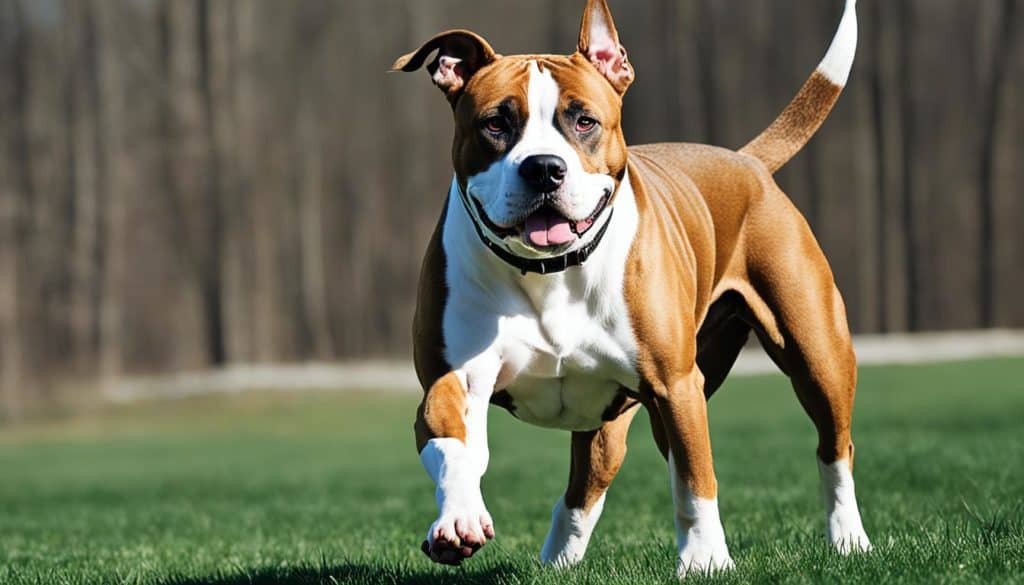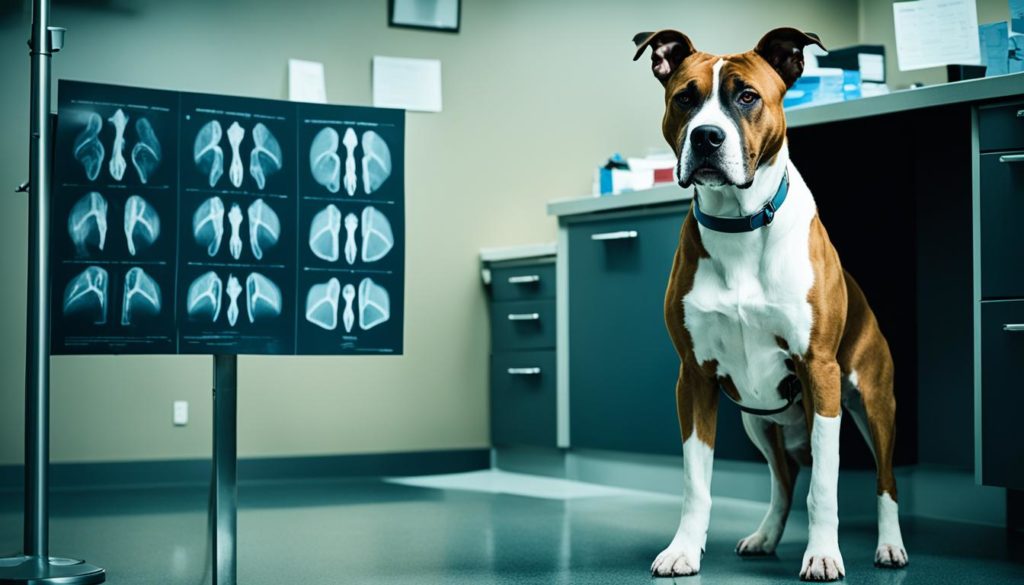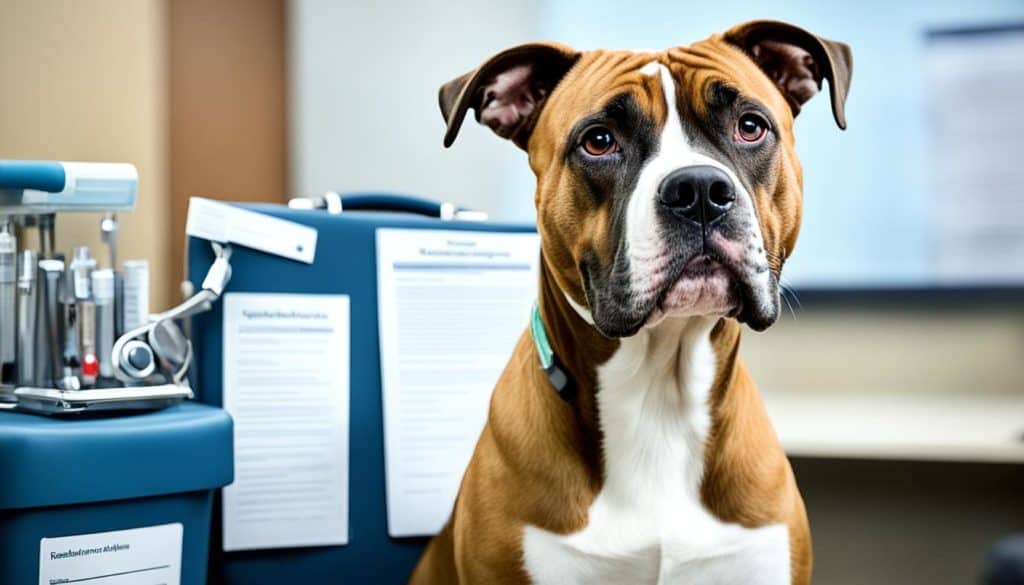The American Staffordshire Terrier, also known as AmStaff, is a popular breed known for its athleticism and loyalty. However, like any other dog breed, AmStaffs are prone to certain health issues that owners should be aware of. By understanding these health concerns and taking preventive measures, you can ensure the well-being of your beloved AmStaff.
Genetics play a significant role in the health of American Staffordshire Terriers. Many genetic conditions are prevalent in this breed, including hip dysplasia, elbow dysplasia, progressive retinal atrophy, hypothyroidism, cerebellar ataxia, and allergies. These conditions can affect the overall quality of life for AmStaffs if not properly managed.
Key Takeaways:
- AmStaffs are prone to genetic health conditions such as hip dysplasia, elbow dysplasia, and progressive retinal atrophy.
- Hypothyroidism, cerebellar ataxia, and allergies are also common health concerns in AmStaffs.
- Regular vet check-ups and preventive measures can help manage and mitigate these health issues.
- Proper exercise, grooming, and nutrition are essential for the well-being of AmStaffs.
- Knowing the health concerns specific to the breed can help you take proactive measures to ensure the long and healthy life of your AmStaff.
The History of the American Staffordshire Terrier
The American Staffordshire Terrier has a rich and captivating history that traces back to its origins in 18th-century England. Originally used for the brutal sports of bullbaiting and dogfighting, the breed’s journey has seen a remarkable transformation over time.
AmStaffs, as they are affectionately known, were initially bred for their incredible strength, tenacity, and agility in the blood sports arena. Their strong jaws and powerful physique made them formidable opponents in the fighting pits. However, as public opinion turned against these cruel activities, a shift occurred in the breed’s purpose.
With the decline of blood sports in the early 19th century, AmStaffs found themselves adapting to new roles. Their intelligence and versatility made them well-suited for a range of tasks, from general farm work to hunting small game. This transition not only showcased the breed’s adaptability but also showcased their loyalty and protective instincts towards their human companions.
The American Staffordshire Terrier’s temperament continued to evolve, and they increasingly became known for their remarkable affection towards their families. Today, their strong bond with their human counterparts has solidified their reputation as devoted and reliable companions.
“The American Staffordshire Terrier is a true family dog. They are fiercely loyal and protective, yet gentle and affectionate with their loved ones.” – Jennifer Davis, experienced AmStaff owner and enthusiast
It wasn’t until 1936 that the breed was officially recognized by the American Kennel Club (AKC), elevating the AmStaff’s status and acknowledging its unique qualities. This recognition solidified their place as a distinct breed and opened up opportunities for continued admiration and responsible ownership.
| Key Milestones in American Staffordshire Terrier History: |
|---|
| 18th century: Origins in England as a bullbaiting and dogfighting breed |
| 19th century: Transition to farm work and small game hunting |
| 20th century: Official recognition by the American Kennel Club (AKC) |
The Physical and Social Traits of American Staffordshire Terriers
American Staffordshire Terriers are distinctive dogs known for their physical and social traits. Let’s explore these unique characteristics that make them such beloved companions.
Physical Traits
AmStaffs have a compact and muscular build, showcasing their strength and athleticism. They typically weigh up to 70 pounds and stand around 17 to 19 inches tall. With their broad chests and well-defined muscles, they exude power and agility.
Their coat comes in a wide variety of colors, including solid colors and combinations. From brindle to blue, fawn to white, their coat colors can be strikingly beautiful.

Grooming an AmStaff is relatively easy due to their short and shiny coat. They require minimal shedding and regular brushing to maintain their coat’s health and shine. Plus, it’s an excellent opportunity for bonding and keeping their coats free from dirt and debris.
Social Traits
One of the most cherished traits of American Staffordshire Terriers is their affectionate and protective nature towards their family. They are known for their loyalty, making them excellent family dogs and devoted companions.
While AmStaffs are friendly and playful by nature, proper socialization is crucial to ensure their compatibility with other animals, especially smaller pets. Early socialization and positive reinforcement training can help them develop good manners and build confident interactions with other animals and humans.
AmStaffs have a natural desire to please their owners, making them highly trainable and responsive to positive reinforcement techniques. Training and socialization should start early to shape their temperament and behaviors.
Their protective nature makes them excellent guard dogs, and they are always ready to defend their loved ones when needed. However, it’s crucial to provide consistent guidelines and establish proper leadership to prevent any potential aggression issues from arising.
In summary, American Staffordshire Terriers possess physical strength and beauty along with social traits that make them valued members of the family. They require regular grooming to keep their coats healthy and minimal shedding. With proper socialization and training, they can be friendly, affectionate, and loyal companions for life.
Exercise and Nutrition for American Staffordshire Terriers
American Staffordshire Terriers are an athletic breed that requires regular exercise to maintain their physical and mental well-being. Engaging in physical activities not only helps keep them physically fit but also stimulates their minds and prevents boredom. It is recommended to provide them with a minimum of 60 minutes of exercise per day, which can include activities such as brisk walks, jogging, playing fetch, or participating in agility training.
In addition to regular exercise, proper nutrition is crucial for the health and vitality of American Staffordshire Terriers. A well-balanced diet is essential to meet their nutritional needs and support their active lifestyle. It is important to feed them a high-quality dog food that contains meat-based protein, vitamins, and minerals. This will help provide them with the necessary energy and nutrients for optimal growth and maintenance.
When determining the feeding schedule for your AmStaff, take into consideration their age, activity level, and overall calorie intake requirements. Puppies may require more frequent meals throughout the day, while adult dogs can be fed two meals a day. Regular monitoring of their weight is important to prevent overfeeding and obesity-related health issues. Consult with your veterinarian to determine the appropriate portion sizes and adjust the feeding schedule as needed.
Common Health Issues in American Staffordshire Terriers
Despite their overall good health, American Staffordshire Terriers are susceptible to certain health conditions. It is important for owners to be aware of these issues and take proactive measures to ensure the well-being of their beloved pets.
Hereditary Diseases
Hereditary diseases are a concern for American Staffordshire Terriers. Some of the common hereditary conditions in AmStaffs include hip dysplasia and elbow dysplasia. These orthopedic disorders affect the joints and can cause pain, lameness, and decreased mobility. Regular check-ups with a veterinarian can help detect and manage these conditions early on.
Progressive Retinal Atrophy
Progressive retinal atrophy is a genetic eye disease that can lead to vision loss or blindness in AmStaffs. Regular eye examinations and early intervention can help slow down the progression of this condition, ensuring the well-being of your pet.
Hypothyroidism
Hypothyroidism is a common endocrine disorder in American Staffordshire Terriers. It occurs when the thyroid gland does not produce enough thyroid hormones, leading to various symptoms such as weight gain, lethargy, and skin issues. Regular blood tests and proper medication can help manage this condition effectively.
Cerebellar Ataxia
Cerebellar ataxia is a neurological disorder that affects the coordination and balance of AmStaffs. Although it is a rare condition, it can cause difficulties in movement and coordination. While there is no cure for cerebellar ataxia, supportive care and physical therapy can help improve the quality of life for affected dogs.
Food and Skin Allergies
American Staffordshire Terriers are prone to food and skin allergies, which can cause itching, skin infections, and gastrointestinal issues. Identifying and avoiding allergens, such as certain proteins or environmental factors, can help manage and prevent allergic reactions.
To ensure the well-being of your American Staffordshire Terrier, it is crucial to provide regular veterinary care, including check-ups, screenings, and vaccinations. Early detection and treatment of any health issues can help prolong the lifespan and improve the quality of life for your beloved AmStaff.

Dental Care and General Health Tips for AmStaffs
Dental care is crucial for maintaining the overall health of American Staffordshire Terriers. Due to their predisposition to dental disease, it is important to implement a regular dental care routine to prevent tooth loss and related health issues in AmStaffs.
Regular teeth brushing and professional cleanings are essential for amstaff dental care. By brushing your AmStaff’s teeth regularly, you can help remove plaque and tartar buildup, which can lead to gum disease and tooth decay. Additionally, professional cleanings by a veterinarian can provide a deeper cleaning to ensure optimal dental health.
AmStaffs are also susceptible to various infections, such as parvo, rabies, and distemper. Vaccination plays a crucial role in protecting your AmStaff from these common infections. Keeping your AmStaff’s vaccinations up to date is essential in maintaining their overall health and well-being.
Monitoring your AmStaff’s weight is another important aspect of their general health care. Obesity can lead to multiple health issues, including joint problems and heart disease. A well-balanced diet and regular exercise are key to preventing obesity and ensuring the overall well-being of your AmStaff.
Parasite prevention is also important for the general health of your AmStaff. Regularly administering flea and tick preventives, as well as heartworm prevention medication, can help protect your AmStaff from harmful parasites and the diseases they carry.
By prioritizing dental care, vaccinations, weight management, and parasite prevention, you can ensure the general health and well-being of your beloved AmStaff.
Training and Behavior Tips for AmStaffs
Training and socialization play a crucial role in shaping the behavior of American Staffordshire Terriers. These intelligent dogs require proper guidance and positive reinforcement techniques to encourage good behavior and prevent any aggressive tendencies towards other animals.
Positive reward-based training methods are highly recommended for AmStaffs. By utilizing treats, praise, and play, you can tap into their natural eagerness to please and motivate them to learn and obey commands. This approach helps build a strong bond between you and your canine companion, enhancing their receptiveness to training.
Consistency, patience, and proper leadership are key to successful training and managing the behavior of AmStaffs.
Adequate socialization is equally important for AmStaffs. Expose them to various environments, people, and other animals from an early age to ensure they become well-behaved and calm in different situations. This helps them develop confidence and adaptability, reducing the likelihood of fear-based reactions or aggression.
Socialization Tips for AmStaffs:
- Introduce your AmStaff to different people, including children and strangers, to help them become comfortable with new faces.
- Expose your dog to various stimuli, such as different sounds, textures, and objects, to build their tolerance and curiosity.
- Arrange controlled, positive interactions with other well-behaved dogs to encourage appropriate social behavior.
Remember, AmStaffs thrive with consistency and clear boundaries. Establish yourself as a calm and confident leader, using positive reinforcement to reward desired behavior and redirect or ignore unwanted behavior. Maintain a regular training schedule and be patient, as these dogs respond best to a steady, dedicated approach.
With proper training and socialization, AmStaffs can develop into well-behaved and loyal companions, showcasing their true loyal and affectionate nature.
| Training and Behavior Tips for AmStaffs | |
|---|---|
| Training Approach: | Positive reward-based training methods, using treats, praise, and play |
| Socialization: | Expose to various environments, people, and animals from an early age |
| Socialization Tips: | Introduce to different people, expose to various stimuli, arrange positive interactions with other dogs |
| Leadership: | Establish as a calm and confident leader, provide clear boundaries |
Feeding and Nutritional Tips for AmStaffs
American Staffordshire Terriers require a well-balanced diet that meets their nutritional needs as a large breed dog. To ensure their health and vitality, it is important to provide them with high-quality dog food that follows Association of American Feed Control Officials (AAFCO) guidelines.
Feeding Schedule:
The feeding schedule for AmStaffs should be adjusted based on their age, activity level, and specific dietary requirements. Puppies require more frequent meals compared to adult dogs. A general guideline is to feed puppies three to four times a day until the age of six months, then transition to two meals a day to support their growth and development. Adult AmStaffs can be fed once or twice a day, depending on their activity level and preference.
Nutritional Requirements:
When selecting dog food for your AmStaff, look for options that provide a balance of protein, healthy fats, and carbohydrates. The protein should primarily come from high-quality meat sources to support their muscle development and maintenance. It’s also important to choose a dog food that is appropriate for their life stage, whether it’s puppy, adult, or senior.
Supplements:
In addition to a well-rounded diet, certain supplements can benefit the overall health of AmStaffs. Joint supplements containing glucosamine and chondroitin can help support their joint health, which is essential for their active lifestyle. Omega-3 fatty acid supplements, such as fish oil, can promote healthy skin and coat, as well as support their immune system.
“Proper nutrition plays a crucial role in maintaining the health and well-being of American Staffordshire Terriers. By providing them with a balanced diet and the necessary supplements, we can support their growth, energy levels, and overall vitality.”
Conclusion
American Staffordshire Terriers are a unique and beloved breed that require proper care to ensure their health and well-being. As with any dog, it is essential for AmStaff owners to be aware of the potential health concerns specific to the breed and take proactive measures to address and manage these issues. By providing regular exercise, proper nutrition, grooming, and preventive veterinary care, AmStaffs can live long and healthy lives.
Regular exercise is crucial for the physical and mental well-being of AmStaffs. Allocating at least 60 minutes of exercise per day, along with engaging activities, can help prevent weight gain and obesity-related health problems. A well-balanced diet consisting of high-quality meat-based protein, vitamins, and minerals is vital to meet the nutritional needs of AmStaffs. Adjusting feeding schedules based on age and activity levels is necessary to prevent weight-related issues.
Grooming an AmStaff is relatively easy due to their short and shiny coat; however, regular brushing and occasional bathing help keep their coat healthy and minimize shedding. It’s also essential to schedule regular visits to the vet for check-ups, vaccinations, and early detection of any potential health concerns. With the right care and attention, AmStaffs can be loyal, loving, and vibrant companions for many years, bringing joy and happiness to their owners’ lives.

